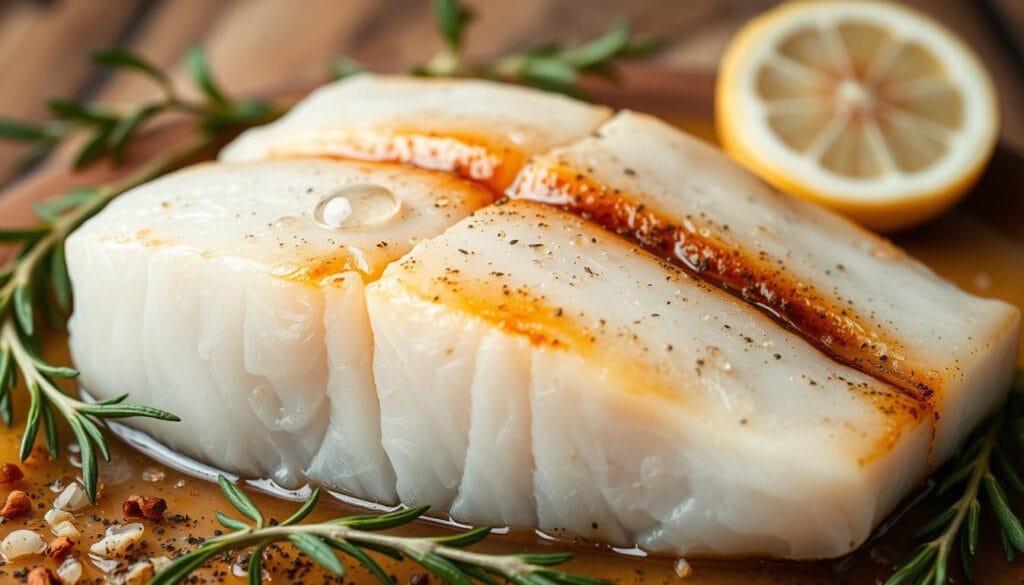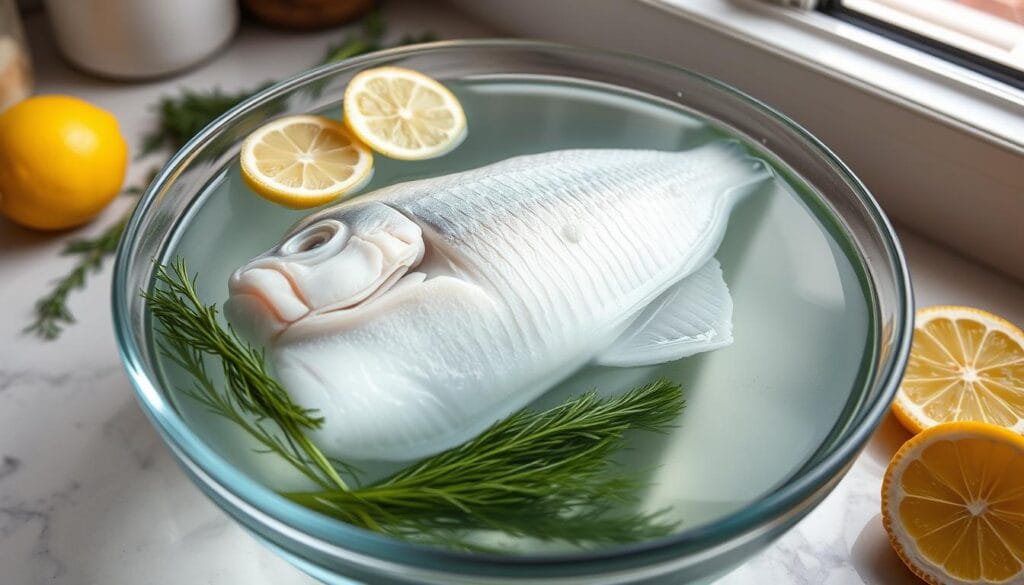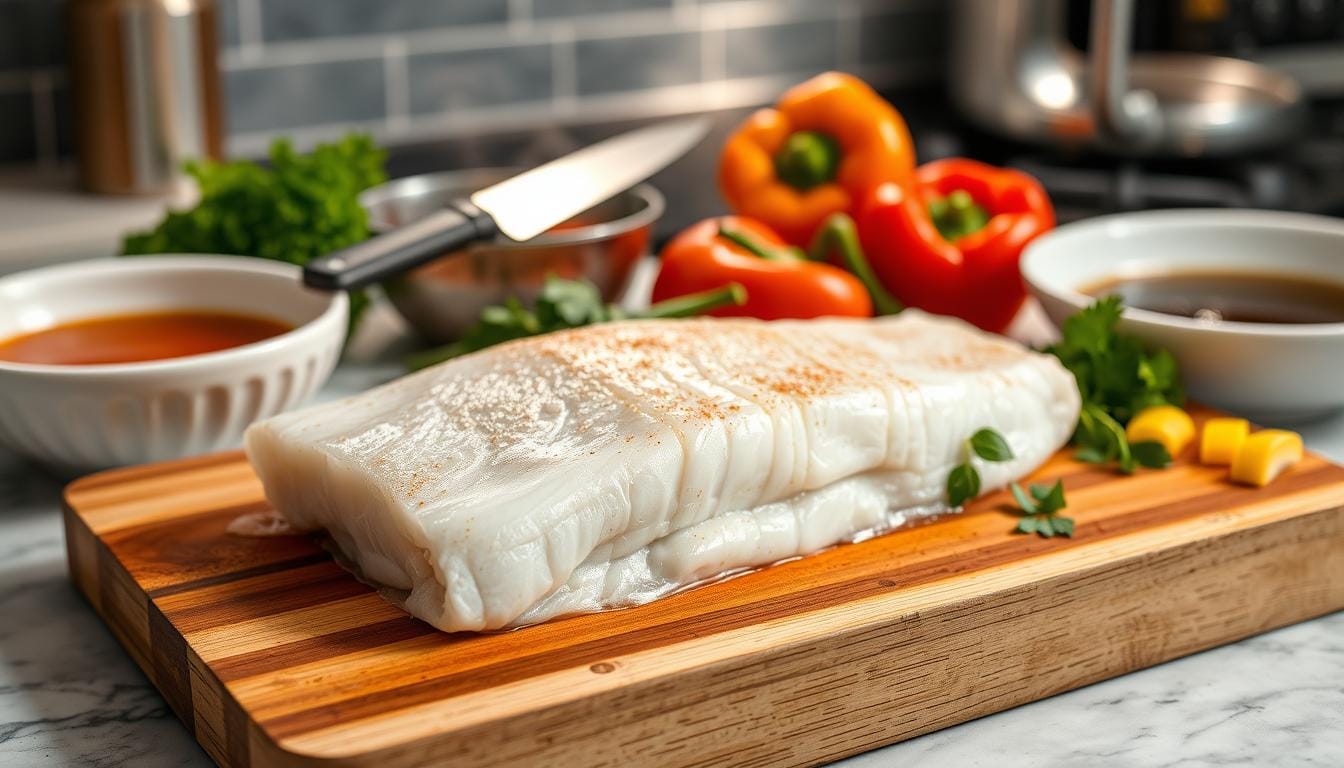Are you tired of serving dry, tasteless halibut that disappoints your dinner guests? Cooking this delicate fish can feel like walking a culinary tightrope, and you might wonder, should you soak halibut before cooking to enhance its texture and flavor?
Halibut is a prized seafood option with a mild flavor and firm texture. Understanding pre-cooking techniques, like soaking, can make all the difference. Unlike filo and phyllo methods, halibut requires a unique approach to retain its moisture and elevate its taste.
Professional chefs know that preparing halibut isn’t just about tossing it in a pan. It demands precision, care, and a deep understanding of the fish’s delicate nature. Your goal is to turn a dry piece of fish into a succulent, mouthwatering meal that will impress even the most discerning palate.
This guide will walk you through the essential steps of halibut preparation, including the role of soaking. You’ll learn expert techniques, critical temperature control methods, and secrets to keep your halibut moist and flavorful every time.
Get ready to elevate your seafood cooking skills and become the culinary expert you’ve always wanted to be. Let’s dive deep into the world of halibut preparation!
Should You Soak Halibut Before Cooking? Understanding Its Unique Properties
Halibut is a remarkable fish with special traits. It’s lean and delicate, unlike fatty fish. This makes it a unique challenge in the kitchen.

Halibut’s meat is different from other fish. It’s low in fat and can lose moisture easily. This means it can dry out quickly if not cooked right.
What Makes Halibut Special
- Extremely lean protein source
- Minimal fat content
- Dense muscle structure
- Delicate flavor profile
The Texture of Halibut Meat
Halibut’s texture is due to its low fat. Its muscle fibers are tight, making it prone to drying out. Chefs must be careful with its moisture.
“Cooking halibut is an art of balance – too little heat, and it’s raw; too much, and it becomes a dry disappointment.”
Why Halibut Dries Out Easily
Halibut lacks fat, so it can’t protect itself from heat. Cooking it requires careful technique, like choosing between butter or olive oil for phyllo dough.
From Alaska’s Region 3A, which catches most Pacific Halibut, to your kitchen. Knowing these traits is key to a great halibut dish.
The Science Behind Soaking Fish in Water

Learning about soaking fish can change how you cook seafood like halibut. When making a halibut and spinach wrapped in filo, you might ask about the best ways to prepare it.
Fish cells are very sensitive to water treatments. Brining mixes salt, water, and proteins in a way that changes texture and taste. When buttering each layer of phyllo, think about how moisture affects it.
“Proper brining is a delicate art that balances chemistry and culinary technique” – Chef Michael Cimarusti, Providence Restaurant
Brining Parameters for Halibut
| Brining Metric | Recommended Value |
|---|---|
| Salt Concentration | 5% |
| Water Quantity | 600 grams |
| Salt Quantity | 50 grams |
| Brining Duration | 1 hour |
| Refrigeration Drying Time | 4+ hours |
The brining process involves several key scientific principles:
- Osmosis allows salt to penetrate fish protein structures
- Saltwater helps prevent moisture loss during cooking
- Protein denaturation occurs, improving meat texture
Good brining keeps your halibut moist, tasty, and flaky. Knowing these molecular interactions makes your seafood cooking more advanced.
Should You Soak Halibut Before Cooking?
Preparing halibut needs careful thought. Some home cooks wonder if soaking is needed. But, chefs often have their own ways of handling this fish.
Experts say handling the fish right is more important than soaking. Your choice depends on the fish’s freshness and how it’s prepared.
Benefits of Saltwater Soaking
- Potential removal of slight surface impurities
- Mild flavor enhancement
- Temporary moisture retention
Potential Drawbacks of Soaking
Soaking too much can ruin the fish’s texture. Halibut’s moisture can get lost, making it taste less good and feel mushy.
Expert Recommendations
Chefs suggest certain ways to prepare:
- Pat fish dry with paper towels
- Avoid direct water contact
- Season immediately before cooking
“The key is minimal manipulation and maximum flavor preservation.”
| Preparation Method | Time Required | Recommended Technique |
|---|---|---|
| Pat Dry | 2 minutes | Use clean paper towels |
| Seasoning | 1 minute | Light salt and pepper |
| Resting | 15 minutes | Room temperature |
Thinking about phyllo dough layers or the difference between filo and phyllo? Remember, handling fish is just as precise. Like with pastry, halibut needs careful, thoughtful handling.
Proper Temperature Control for Cooking Halibut
Cooking halibut needs precision and careful temperature control. This ensures the fish stays moist and tastes great. Professional chefs know that getting the temperature right is key to avoiding dry, tough fish.
Here are some important temperature tips:
- Sous vide cooking temperatures range from 105°F to 150°F
- At 120°F, halibut starts to soften
- 130°F makes it flaky
- 140°F gets it chewy
“Cooking fish is an art of subtle temperature control” – Culinary Experts
The USDA says fish should be cooked to 145°F to kill harmful bacteria. Halibut experts recommend keeping it between 130°F and 135°F for the best moisture.
Cooking time is also important. For 1-inch fillets, cook for 30-45 minutes. For 2-inch fillets, cook for 45-60 minutes. Keep an eye on your fish to avoid overcooking.
Knowing how temperature affects texture is key to cooking halibut well. It’s like learning to keep phyllo shells from getting soggy or choosing the right oil for phyllo dough.
Remember, different cooking methods affect how well you can keep the temperature. Baking, poaching, and grilling each need a special approach to keep halibut moist.
Should You Soak Halibut Before Cooking? Essential Pre-Cooking Preparation Steps
Preparing halibut needs careful attention to get a delicious dish. Whether it’s a halibut and spinach wrapped in filo or a simple seared fillet, proper prep is key. This ensures your dish tastes like it came from a restaurant.
Cleaning with Precision
Fresh Pacific halibut needs careful handling. Cleaning your fish involves these important steps:
- Never rinse the halibut under water
- Use a lint-free cloth or paper towel to gently wipe the surface
- Remove any visible scales or debris carefully
- Avoid touching the entrail liquid
Patting Dry for Perfect Texture
Moisture ruins a crisp halibut exterior. After cleaning, dry the fish well with paper towels. Do you have to butter each layer of phyllo? Not always, but a dry surface is key for a golden-brown sear.
Seasoning Techniques
| Seasoning Type | Recommended Amount | Best Used With |
|---|---|---|
| Sea Salt | 1/2 teaspoon per fillet | Grilled or pan-seared halibut |
| Black Pepper | 1/4 teaspoon per fillet | All cooking methods |
| Herbs de Provence | 1 teaspoon | Baked halibut dishes |
Marination Options
Marinating can make your halibut amazing. For a great flavor, try a quick marinade:
- Lemon juice (2 tablespoons)
- Olive oil (1 tablespoon)
- Minced garlic (1 clove)
- Fresh herbs (chopped parsley or dill)
Pro tip: Limit marination time to 20-30 minutes to prevent the fish from becoming mushy.
Best Cooking Methods for Moist Halibut
Cooking halibut well needs precision and skill. You want to keep the fish moist and cook it just right. Different ways to cook can make your halibut dish truly special.
Recommended Cooking Techniques
- Pan-Searing: Heat your pan to 425°F and cook for 7-9 minutes total
- Baking: Use 425°F for 9-10 minutes until internal temperature reaches 130°F
- Smoking: Maintain 275°F for 30-40 minutes
- Grilling: Cook for 8-10 minutes depending on thickness
When cooking halibut, keeping an eye on the temperature is key. The ideal internal temperature is between 125°F and 135°F. This ensures the fish stays tender and moist.
“The key to perfect halibut is watching the temperature like a hawk and removing it just before it overcooks.” – Professional Chef
Moisture Retention Strategies
- Baste with butter or oil during cooking
- Use high-smoke point oils like grapeseed or avocado
- Rest the fish for 3-10 minutes after cooking
- Avoid overcooking by checking internal temperature
| Cooking Method | Temperature | Cooking Time |
|---|---|---|
| Pan-Searing | 425°F | 7-9 minutes |
| Baking | 425°F | 9-10 minutes |
| Smoking | 275°F | 30-40 minutes |
| Grilling | High heat | 8-10 minutes |
Exploring cooking methods can lead to interesting techniques like using phyllo dough. Just as the right number of phyllo layers can make a dish better, the right cooking method can make your halibut shine. Filo and phyllo dough have their differences, just like the various ways to cook fish.
Tips for Preventing Dry Halibut
Cooking halibut can be tricky because it’s lean. But with the right techniques, you can make it moist and delicious. This will impress seafood lovers.
Timing Considerations
Timing is key when cooking halibut. It’s important to prevent it from drying out. Here are some timing tips:
- Cook halibut for a short duration
- Use a cooking thermometer to monitor internal temperature
- Aim for 130°F to 135°F internal temperature
- Remove from heat when fish just begins to flake
Moisture Retention Techniques
To keep halibut moist, use these preparation methods:
- Brine the fish before cooking
- Use gentle cooking methods like poaching or sous vide
- Baste with melted butter during cooking
- Cover the fish while cooking to retain moisture
Common Cooking Mistakes to Avoid
To avoid dry halibut, avoid these mistakes:
- Avoid high-heat cooking methods
- Never overcook the fish
- Let the halibut rest after cooking
- Use proper seasoning to enhance flavor
“The secret to perfect halibut is treating it with respect and understanding its delicate nature.” – Seafood Chef Recommendation
| Cooking Method | Recommended Time | Moisture Retention |
|---|---|---|
| Sous Vide | 45-60 minutes | Excellent |
| Pan Searing | 3-4 minutes per side | Good |
| Baking | 10-12 minutes | Moderate |
Remember to let your halibut rest for a few minutes after cooking. This helps the juices redistribute, making it tender and juicy. With these tips, you’ll always cook moist halibut.
Professional Techniques for Handling Halibut
Professional chefs know how important it is to handle halibut right. This keeps its flavor and texture just right. Whether you’re making a halibut and spinach dish or grilling a filet, how you do it is key.
Here are some important handling tips:
- Clean your workspace well before you start with the fish.
- Use special cutting boards for raw fish.
- Keep the halibut cold, at 40°F or below.
- Don’t clean fish in public areas to avoid germs.
When working with halibut, be careful with the phyllo layers. Chefs say to handle it gently to avoid breaking the fish.
“The key to exceptional halibut is treating it with respect from catch to plate.” – Seafood Culinary Expert
Choosing fresh halibut is important. Look for:
- Clear, bright eyes
- Firm flesh that springs back when touched
- Clean, ocean-like smell
- No visible discoloration
For storage, keep fresh halibut cold for 1-2 days. Freeze it in airtight containers if you won’t use it right away. Always keep the fish cold and use clean tools to keep its quality high.
Pro tip: Always pat your halibut dry before cooking to achieve the perfect sear and prevent excess moisture.
Storage and Preparation Best Practices
Preparing halibut needs careful attention to keep its flavor and texture right. Knowing how to store and prepare it will help you get the best out of your fish.
- Clean your cutting surface thoroughly before preparation
- Rinse the whole fish gently with cold water
- Pat the fish dry using clean paper towels
- Store in the coldest part of your refrigerator
How long you store halibut depends on when you plan to cook it. Fresh halibut can stay in the fridge for up to two days. If you want to keep it longer, freeze it right away.
“Proper handling is key to maintaining the delicate flavor of halibut.” – Professional Seafood Chef
When talking about storage, remember the similarities with phyllo dough. Just like wondering about phyllo layers, halibut needs careful handling. The difference between filo and phyllo is like the careful steps needed for seafood.
| Storage Method | Duration | Recommended Temperature |
|---|---|---|
| Refrigerated (Fresh) | Up to 2 days | 32-38°F |
| Frozen | Up to 3 months | 0°F or lower |
When thawing frozen halibut, always thaw it in the fridge. This keeps its quality. Don’t thaw it at room temperature, as it can ruin the fish’s texture and safety.
Conclusion
Preparing halibut is an art that requires skill, timing, and knowledge of the fish’s delicate nature. You don’t have to make it complicated. Knowing how to keep phyllo shells from getting soggy and choosing between butter or olive oil for flavor is key. It’s all about respecting the fish and using the right cooking methods.
Que vous fassiez tremper votre flétan ou non, gardez-le humide et obtenez la bonne texture. Les Instituts nationaux de la santé disent que manger des fruits de mer comme le flétan deux fois par semaine est bénéfique pour votre bien-être. Avec les bonnes techniques, un simple filet peut devenir un plat floconneux, tendre et délicieux.
Cuire le flétan consiste à être précis. Saisissez-le à la poêle pendant 3 à 5 minutes de chaque côté, en vous assurant qu’il atteigne 145°F. Savoir que la saison fraîche du poisson dure 8 mois améliorera également vos compétences. Votre objectif est de faire un plat non seulement nourrissant, mais aussi inoubliable, mettant en valeur les saveurs délicates du poisson.
Chaque cuisinier a sa propre façon de préparer le flétan. Faites confiance à vos instincts, essayez de nouvelles techniques et profitez de la préparation de repas nourrissants et savoureux qui célèbrent les trésors de l’océan.
FAQ
Q: Is halibut a delicate fish that requires special preparation?
A: Yes, halibut is a lean fish with a delicate texture. It can dry out if not cooked right. Its low fat content makes it tough and less flavorful when overcooked. So, use careful cooking techniques to keep it moist and tasty.
Q: Should I soak halibut in water before cooking?
A: No, soaking halibut is not needed. Unlike some fish, halibut doesn’t need soaking before cooking. Instead, focus on drying the fish well and using methods that keep it moist for a tender, flavorful dish.
Q: What is the best way to prevent halibut from drying out?
A: To keep halibut moist, try these methods:
– Cook at lower temperatures
– Use moist-heat cooking
– Avoid overcooking
– Baste during cooking
– Marinate before cooking
– Cook for a short, precise time
Q: What are the optimal cooking temperatures for halibut?
A: Cook halibut between 325-375°F (163-190°C). For baking, aim for 350°F. Cook until it reaches 130-135°F internally. This ensures it’s cooked through without drying out.
Q: How long should I cook halibut?
A: Cooking time varies based on thickness and method. For baking, cook about 10 minutes per inch of thickness. A 1-inch thick fillet takes 8-12 minutes at 350°F. Always check with a meat thermometer for doneness.
Q: Can I freeze halibut before cooking?
A: Yes, you can freeze halibut. Wrap it tightly in plastic or a freezer bag, removing air. Freeze at 0°F (-18°C) for up to 3-4 months. Thaw slowly in the fridge to keep its texture and prevent moisture loss.
Q: What are the best seasoning options for halibut?
A: Halibut goes well with light, fresh seasonings. Try:
– Lemon and herbs (dill, parsley, thyme)
– Garlic and butter
– Cajun or Mediterranean spice blends
– Citrus marinades
– Simple salt and pepper with olive oil
Q: What cooking methods work best for halibut?
A: The best methods for halibut include:
– Baking
– Poaching
– Grilling (with careful temperature control)
– Pan-searing
– Broiling (for a short time)
Each method needs attention to prevent overcooking and keep it moist.

